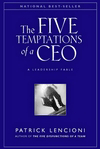This quick read can make a significant difference in your effectiveness of your leadership characteristics and business interactions with others. The book is one of three in a series which conveys the "Five Temptations" effectively in fable form, followed by a summary and discussion by Patrick Lencioni - it takes no more than an hour to read and is easily one of the best challenges for current leaders!
The book is based upon a fictional character named Andrew O'Brien, a San Francisco Bay Area tech CEO. His company is underperforming and a critical annual meeting of the board of directors is happening the next day. Andy finds himself working extremely late when he discovers the bridge he must cross to go home is closed due to planed construction. Andrew decides to use the commuter train to get home, which is practically deserted except for an insightful and cheerful janitor called Charlie.
After some cautious hesitation the two men began to talk, and Andrew soon learns that Charlie is a knowledgeable son of a railroad ex-CEO. It is from this conversation and Charlie's lessons learned from his father that Andy learns how Leaders like himself often fail or succeed. This exploration is centered around the "Five Temptations" that challenge leaders and executives: Successful Leaders choose trust over invulnerability.
Successful Leaders choose constructive conflicts over harmony.
Successful Leaders seek clarity of efforts over certainty of outcomes.
Successful Leaders choose accountability over popularity.
Successful Leaders choose results over their status.
Charlie is an unexpected source of wisdom who shares valuable insight and perspectives with Andrew. Stepping through time the way that only a fable can we encounter other passengers on the train who turn out to be CEO's of other companies. This creates a fraternity of Leaders who all describe their unique challenges and how the understanding of the "Five Temptations" has allowed them to move their organizations in a positive direction.
As with most fables the simplicity of the message is what is truly important not how real the practical situation is or could be described in the story. Keep in mind the key points and how they can be integrated with others and built upon to create a pallet of Leadership competencies useful for anyone.
Part II in the "Afterworld" starts on page 105. This is the section which can best be used to help with professional development of Leaders by providing a clear model and concise explanation for each temptation. Business still needs to be executed by Leaders but a framework which supplies guidance and suggestions for interpersonal success, acceptance of accountability and questioning to get to the real answers is a formula for success. |
 The Five Temptations of a CEO: A Leadership Fable
The Five Temptations of a CEO: A Leadership Fable